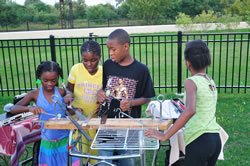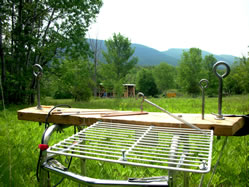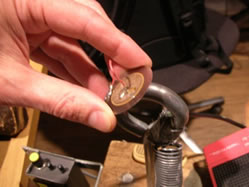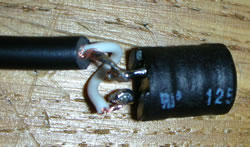Handheld Audio Art Devices

Instrument making brings a rewarding sense of discovery and contact with new vibrational sources and behaviours. In this article I will describe my encounters with a few basic electronic components that directly translate physical hand gestures into electronic sounds. These components, or devices, satisfy my interest in discovering the hidden sound potential residing in everyday and readily available materials.
The self-built piezo disk contact microphone is my device of choice. They are inexpensive and easy to make. It is the key component to the Springboard 1[1. More about the Springboard can be read in “The Springboard: The Joy of Piezo Disk Pickups for Amplified Coil Springs,” Leonardo Music Journal 17 (December 2007) and “The Springboard: The Joy of Piezo Disk Pickups for Amplified Coil Springs,” eContact! 10.3 — Toronto Electroacoustic Symposium 2007 (TES) / Symposium Électroacoustique 2007 de Toronto. The “Experimental Instruments” page on my website is currently devoted to the Springboard, and a special version of my Gearwire video for Handmade Electronic Music: The Art of Hardware Hacking (Nicolas Collins, Ed., Routledge: 2006) can be seen on the accompanying DVD, or on vimeo.com: “Springboard for Hardware Hacking DVD.”], an instrument I built in 1994 to explore the sonic potential of coil springs and other readily available materials and objects. Applied in music or sound design contexts, anyone can discover and create extraordinary world of sounds that belie their humble origin.

Among the most effective uses of the piezo disk contact pickup is the daxophone made by Hans Reichel. A variation on this amazing instrument exists on the Springboard. In 2007 Gearwire produced a set of videos about my instrument in which I talk and demonstrate the variety of sounds I make. 2[2. “The Springboard: Contact Mics Make Lovely Noise On The Cheap.” Gearwire, 19 June 2007.]
Sonic Playground
Piezo disk contact microphones are very easy and inexpensive to make. MFA student Kyle Evans created a video of my sound students at The School of the Art Institute of Chicago (SAIC) as they were building and testing that is available on YouTube. 3[3. “SAIC Instrument Construction Class — March 2010,” posted by YouTube user “yakthekyle” (26 March 2010, dur. 3:17).]
With some adult supervision I have never been shy to have children use piezo disk contact microphones. A case in point was the Sonic Playground public event in 2009, organized by Inferno Mobile Recording Studio with support from the Chicago Park District. 4[4. “The Inferno Mobile Recording Studio: Helping Chicago teens explore their creative potential.” Examiner.com, 11 April 2009. A video of the event, “Sonic Playground,” was produced by Great Scott Media and is available on vimeo.com (5:00).] The aim of this series was to activate a playground so that anyone, adults and children could make sounds, and even music. I was one of the local sound artists who were invited accomplish this sonic activation and interaction for one evening. Using Roland’s portable amplifiers allows us all to “prospect” for interesting tones and resonances in and on the playground’s equipment.
With simple friction mallets, balloons, PVC pipes and corrugated tubing, the local kids and I could make sounds both acoustically and electroacoustically — and immediately. This is important: without time to workshop the use of devices that sonically activated the playground equipment, minimal verbal explanation was absolutely necessary. They key to the success of the event was that everyone (joining us were members of the World Listening Project and Inferno Mobile Recording Studio) could participate in making sounds, with familiar object and materials, as shown in the video mentioned above.
Like the magnet and coil of a loudspeaker, a piezo disk is also reversible, working as a small loudspeaker itself. When used as such a piezo disks favour the mid- and upper-frequency range — good for travel alarms and other beeping devices. But, when plugged into the earphone jack of a handheld radio receiver or audio playback device, these thin, high-frequency narrowband sounds emphasize the mediated nature of radio transmissions. These in turn are played into the Springboard simply by physically touching the disk to the instrument. Subtle variations in timbre are made by manually rolling the disk around and across the surfaces and edges of the Springboard, as if I were using a parametric equalizer on the signal.

Coils but no Spring…
The inductor is another marvellously simple device that has proven very useful when combined with real-time digital processing and a literal “wave of the hand.” It is a small electronic component with an essential role in all types of circuits. The inductor differs from a piezo disk because it doesn’t pickup the vibration of objects. No contact is needed. It is a coil of wire that picks up invisible electromagnetic fields surrounding any active electrical devices.

No larger than a than an electret condenser microphone element, an inductor soldered to an audio cable is truly a handheld device with marvellous ability to pickup up the invisible electromagnetic fields that exist around almost any active electronic device: cell phones, laptops, dimmer switches, LCDs, and more.
An example of this can be heard in my music for a recent theatre production, From a Fading Light by Plasticene. I employed the real-time software and Max/MSP patches by Tom Erbe, Michael Norris, Nobuyasu Sakonda, with the inductor held over the laptop as recorded on the very same laptop. It produced sweeping gestures that translated my sweeping hand motions into the sweeping electronic sounds for a satisfying sound score. 5[5. The audio from this piece is available on Soundcloud.com.]
Conclusion
Handheld devices enable the user to make sounds that have infinitely and subtly variable gestural qualities. With that these sounds can be made through technically simple, direct means. The tools needed to make the devices are affordable, though a little research and inquiry is necessary to learn where to acquire them.
More information and useful links can be found in the “experimental instruments” area of my website: “Sources and materials for making contact microphones, instruments, etc.”
Social top